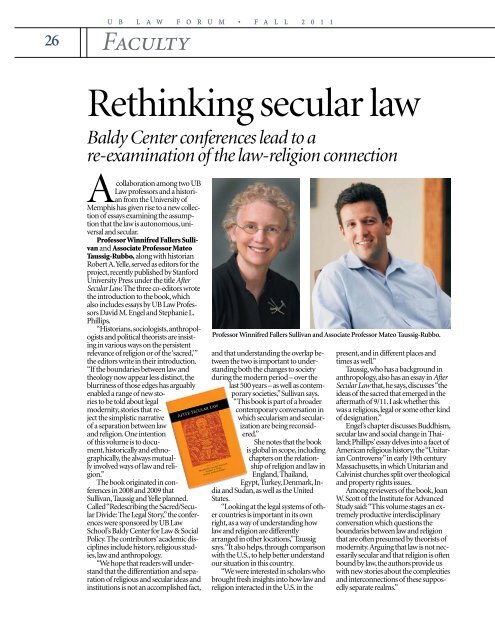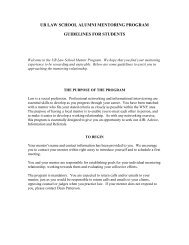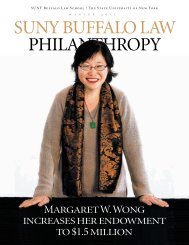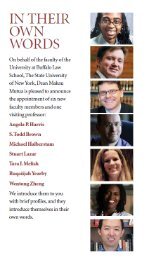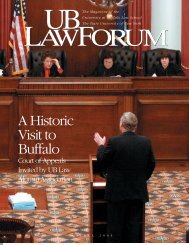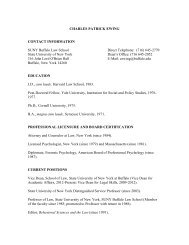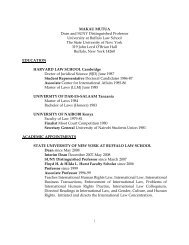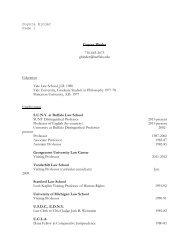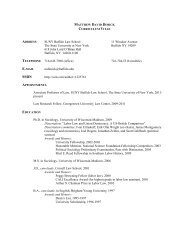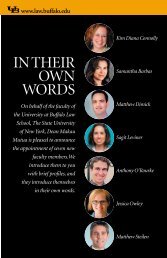0 Law cover 2010 (Page 203) - SUNY Buffalo Law School - University ...
0 Law cover 2010 (Page 203) - SUNY Buffalo Law School - University ...
0 Law cover 2010 (Page 203) - SUNY Buffalo Law School - University ...
Create successful ePaper yourself
Turn your PDF publications into a flip-book with our unique Google optimized e-Paper software.
26<br />
U B L A W F O R U M • F A L L 2 0 1 1<br />
Faculty<br />
Rethinking secular law<br />
Baldy Center conferences lead to a<br />
re-examination of the law-religion connection<br />
Acollaboration among two UB<br />
<strong>Law</strong> professors and a historian<br />
from the <strong>University</strong> of<br />
Memphis has given rise to a new collection<br />
of essays examining the assumption<br />
that the law is autonomous,universal<br />
and secular.<br />
Professor Winnifred Fallers Sullivan<br />
and Associate Professor Mateo<br />
Taussig-Rubbo, along with historian<br />
Robert A.Yelle,served as editors for the<br />
project,recently published by Stanford<br />
<strong>University</strong> Press under the title After<br />
Secular <strong>Law</strong>. The three co-editors wrote<br />
the introduction to the book,which<br />
also includes essays by UB <strong>Law</strong> Professors<br />
David M.Engel and Stephanie L.<br />
Phillips.<br />
“Historians,sociologists,anthropologists<br />
and political theorists are insisting<br />
in various ways on the persistent<br />
relevance of religion or of the ‘sacred,’”<br />
the editors write in their introduction.<br />
“If the boundaries between law and<br />
theology now appear less distinct,the<br />
blurriness of those edges has arguably<br />
enabled a range of new stories<br />
to be told about legal<br />
modernity,stories that reject<br />
the simplistic narrative<br />
of a separation between law<br />
and religion.One intention<br />
of this volume is to document,historically<br />
and ethnographically,the<br />
always mutually<br />
involved ways of law and religion.”<br />
The book originated in conferences<br />
in 2008 and 2009 that<br />
Sullivan,Taussig and Yelle planned.<br />
Called “Redescribing the Sacred/Secular<br />
Divide: The Legal Story,”the conferences<br />
were sponsored by UB <strong>Law</strong><br />
<strong>School</strong>’s Baldy Center for <strong>Law</strong> & Social<br />
Policy.The contributors’academic disciplines<br />
include history,religious studies,law<br />
and anthropology.<br />
“We hope that readers will understand<br />
that the differentiation and separation<br />
of religious and secular ideas and<br />
institutions is not an accomplished fact,<br />
Professor Winnifred Fallers Sullivan and Associate Professor Mateo Taussig-Rubbo.<br />
and that understanding the overlap between<br />
the two is important to understanding<br />
both the changes to society<br />
during the modern period – over the<br />
last 500 years – as well as contemporary<br />
societies,”Sullivan says.<br />
“This book is part of a broader<br />
contemporary conversation in<br />
which secularism and secularization<br />
are being reconsidered.”<br />
She notes that the book<br />
is global in scope,including<br />
chapters on the relationship<br />
of religion and law in<br />
England,Thailand,<br />
Egypt,Turkey,Denmark,India<br />
and Sudan,as well as the United<br />
States.<br />
“Looking at the legal systems of other<br />
countries is important in its own<br />
right,as a way of understanding how<br />
law and religion are differently<br />
arranged in other locations,”Taussig<br />
says.“It also helps,through comparison<br />
with the U.S.,to help better understand<br />
our situation in this country.<br />
“We were interested in scholars who<br />
brought fresh insights into how law and<br />
religion interacted in the U.S.in the<br />
present,and in different places and<br />
times as well.”<br />
Taussig,who has a background in<br />
anthropology,also has an essay in After<br />
Secular <strong>Law</strong> that,he says,discusses “the<br />
ideas of the sacred that emerged in the<br />
aftermath of 9/11.I ask whether this<br />
was a religious,legal or some other kind<br />
of designation.”<br />
Engel’s chapter discusses Buddhism,<br />
secular law and social change in Thailand;<br />
Phillips’essay delves into a facet of<br />
American religious history,the “Unitarian<br />
Controversy”in early 19th century<br />
Massachusetts,in which Unitarian and<br />
Calvinist churches split over theological<br />
and property rights issues.<br />
Among reviewers of the book,Joan<br />
W.Scott of the Institute for Advanced<br />
Study said:“This volume stages an extremely<br />
productive interdisciplinary<br />
conversation which questions the<br />
boundaries between law and religion<br />
that are often presumed by theorists of<br />
modernity.Arguing that law is not necessarily<br />
secular and that religion is often<br />
bound by law,the authors provide us<br />
with new stories about the complexities<br />
and interconnections of these supposedly<br />
separate realms.”


